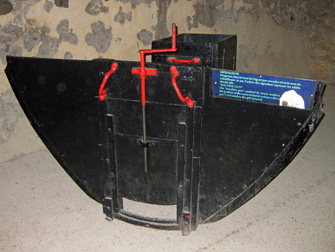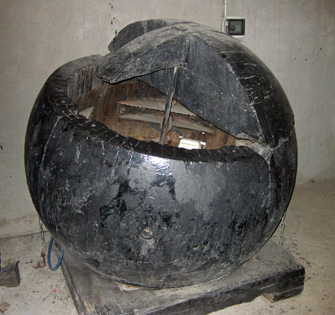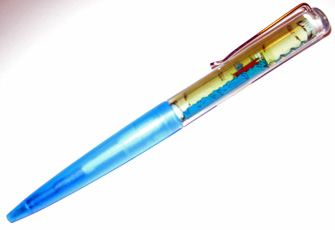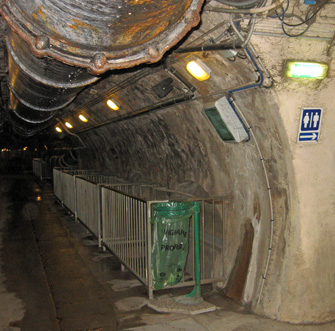 |
|
Like Mohawk high-steel construction workers, Paris sewer men pride themselves on being able to walk on top of the guardrails. I wish. |
This is Part II of a two-part article. Read Part I here.
Under Napoleon Bonaparte, the Parisian water supply and disposal systems were greatly improved. The emperor built the Canal d’Ourq, which brought unprecedented amounts of clean, fresh water into the city from the northeast. This was a boon for the people of Paris, but of course once all that water was no longer so clean and fresh, it had to be dealt with. Napoleon faced this challenge with the help of a heroic figure in the annals of muck: Emmanuel Bruneseau (1756-1826), whose fortuitously apt last name could be literally but ungrammatically translated as “Brownbucket.”
According to the museum’s blurb, Bruneseau “overcame superhuman difficulties to make a complete survey of the existing facilities between 1805 and 1812.” That’s a superhumanly long time to be wading around in excreta. Personally, I suspect that he may not have actually completed his survey (do you want to check his work?), but after eight years had had enough of the miasma and ran off to join Napoleon’s army in Moscow, practicing along the way how to say “Just shoot me!” in Russian.
Anyway, Napoleon, relying on Bruneseau’s say-so, did some expanding and upgrading, but it wasn’t until Baron Haussmann renovated Paris’s streets and boulevards in the mid-19th century that the city was given a complete sewer system worthy of the name. This was due to the efforts of another icon of elimination: Eugène Belgrand, the engineer who devised the network that still, with some extensions, serves the city today. It took a while, but by 1894 every street in town had its sewer, every building was connected to the system, and every sewer was large enough to be patrolled, the display says, by “a man of average height walking upright.” What the display doesn’t say is “except for the 45 percent of the time when he’s doubled over gagging.”
Belgrand’s system was considered radically visionary at the time. The museum describes it as a “totally new concept: having the wastewater discharged far downstream from Paris.” In other words, in more than 2,000 years of continuous, densely populated settlement, this had never occurred to anyone before. This absolutely astounds me. What were they thinking all that time?
“Hey, Lou, does this water taste funny to you?” “Yeah, kind of. Where’d you get it?” “The usual place, just below the dead horse market at Pont Neuf. You know — where they empty the chamber pots from the leper colony.” “Hmm. Must be something wrong with the bucket.”
Speaking of hygiene, another leitmotif in the tour is information about how they clean the sewers. There are at least five different displays devoted to the various manual devices, boats and dredges that they use, or used to use, to keep the mains clear and flowing. Some of them look exactly like you would expect:
 |
|
This sewer cleaning device is simply pushed forward by hand. I bet the guy who invented it also invented rubber gloves. And about seven new curse words. |
While others are rather surprising:
 |
|
They use huge balls like these to clean out the large circular conduits. |
Then I guess somebody has to clean the ball. And then somebody has to clean the ball cleaning equipment. And then somebody has to clean the ball cleaning equipment cleaning materials. And so on.
Interestingly, the operative euphemism at the Sewer Museum for the solid matter that somehow manages to collect in sewer mains (it’s the dangedest thing!) is “sand.” Not mud, not sludge, but “sand.” Not residue, soil, silt, gunk or goo, but “sand.” And it’s not an English mistranslation either, because the French word they use is sable. I can see the recruitment ads now: “Cleaning the sewers is like a day at the beach!”
Not surprisingly, after you get hired for the job, one of the first things you need is a pair of stout waterproof boots:
 |
|
I hope these clompers have firm-gripping cleats on the soles. Nobody wants to slip and fall in the “sand.” |
But it looks like they should be issuing wetsuits for some of the assignments:
 |
|
Whatever you do, don’t drop the pole. Or forget which end you were using. |
My guess is that the guys who ream out the mains look down upon but secretly envy the people who run the museum’s gift shop. Yes, there’s a gift shop — who would want to go home without a nice keepsake from the sewer? You can get Egouts de Paris T-shirts (emblematic white only), baseball caps, fridge magnets, sliding tile puzzles and keychains. Also a Sewers of Paris carafe, which has to be the worst-advised choice in the history of branding (take a big swig!). But my favorite theme gifts are the plush toy rats for kids. This is where the “cheerful acceptance” of rodents mentioned in Part I of this article escalates into more of a “wholehearted embrace”:
 |
|
Soft, cute and cuddly — just like the real thing! |
And for aspiring Hugos, there’s a novelty ballpoint pen with a little figure of a sand-pushing boat that plies its way down the sewer when you tilt it:
 |
|
I bought one of these novelty “Sewer Dredger” pens, and it takes rather a lot of effort to get the boat to move down the channel. Probably just like the real thing. |
And finally, yes, there are restrooms:
 |
|
Couldn’t that arrow under the WC sign be pointing just about anywhere? |
It may be purely for the sake of decorum, but they have lavatory facilities in the Sewer Museum, presumably with the shortest pipes in Paris. Also, these are probably the only restrooms in France, if not the world, with a sign on the door saying:
“Employees must not wash hands before returning to work.”
Okay, actually there’s no such sign. I’m sanding you.
The Musée des Égouts de Paris is located across from 93, quai d’Orsay on the Left Bank side of the Pont d’Alma. Click here for map.
© 2011 Paris Update
FavoriteAn album of David Jaggard’s comic compositions is now available for streaming on Spotify and Apple Music, for purchase (whole or track by track) on iTunes and Amazon, and on every other music downloading service in the known universe, under the title “Totally Unrelated.”
Note to readers: David Jaggard’s e-book Quorum of One: Satire 1998-2011 is available from Amazon as well as iTunes, iBookstore, Nook, Reader Store, Kobo, Copia and many other distributors.
